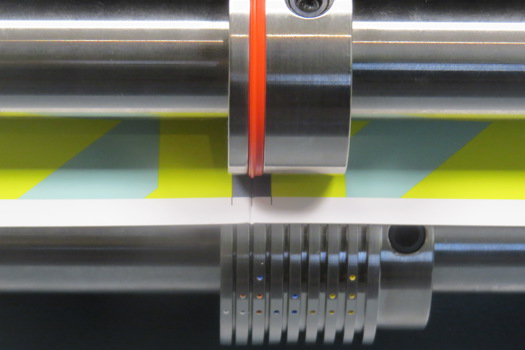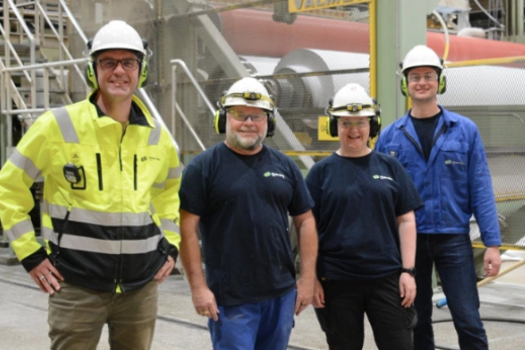In June this year, a paper mill in Spain will take a revolutionary step when it replaces the fresh water it uses at its site with recycled municipal effluent. After the transition is made Holmen's paper mill, situated near Madrid, will be the first in Europe to manufacture paper from 100% recovered paper using 100% recycled water. The possibility of re-using the mill's own waste water is also being considered, a move that would make the plant even more environmentally friendly.
While this sounds like an extraordinary measure, for the European paper industry it's just another step down the road towards a greener future. Despite being pilloried by the media, the paper industry is one of the greenest - if not the greenest - industry sectors. Anyone unconvinced by this statement should check out the facts, according to Martyn Eustace, director of Two Sides, the initiative to promote a sustainable print and paper industry.
"Forestry is a renewable resource and if you link that to increasingly high rates of use of bio-mass [fuels] it can be used very efficiently," explains Eustace. "Fifty per cent of the industry's energy comes from bio-mass and the industry is also the biggest recycler in Europe," he continues, "so there are some very good statistics out there showing that the industry is doing a huge amount."
You don't need to look far to find the kind of examples of environmental best practice in the paper manufacturing industry that Eustace is referring to. In recent months a number of companies have introduced measures to reduce their impact on the environment and some major successes have been scored.
Take Iggesund Paperboard, for example. The company recently announced that it has reduced fossil carbon dioxide emissions by 65% at its Bruk Mill in Sweden. Around 95% of the mill's energy consumption is from bio-fuel with the mill's energy supply based on heat from its own production process, plus electricity.
"In the chemical pulping process more than 50% of the wood is used as energy so that very energy is used to drive the board mill, generate electricity for our own use and dry wood at a nearby sawmill. It's also used to heat 1,000 private homes in the village of Iggesund," explains Staffan Sjöberg, spokesman for Iggesund Paperboard.
While this feat is impressive in it's own right the company's ambitions don't stop there. "We are planning for a new recovery boiler and an upgrade of our equipment for the generation of electricity from steam," explains Sjöberg. "These investments will be one large step for us to become 100% bio-driven and self-sufficient on electricity."
Rise of bio-fuels
Bio-fuels are rapidly becoming the energy option of choice for paper manufacturers, replacing carbon dioxide-intensive fossil fuels. However, there is no one-size-fits-all solution; it has to be the right kind of bio-fuel to make these efforts worthwhile. Sjöberg explains that while bark from pine trees has an energy content four or five times lower than oil per tonne, tall oil, one of the by-products of the company's pulping process, is around 90% as energy efficient as oil.
Another company with similar green ambitions to Iggesund is Tullis Russell. It recently signed a multimillion pound deal with RWE Npower Renewables to supply its paper mill at Markinch, Fife, with heat and electricity from a new bio-mass fuelled co-generation plant.
"The plant replaces our existing coal-fired power plant and will reduce Tullis Russell's fossil carbon emissions by 70% [250,000 tonnes] and represent 6% of the Scottish government's renewable energy targets," explains Christine Wood, Tullis Russell's corporate social responsibility manager.
Mixed resources
The power plant is due to start operating in 2012 and when fully up and running it will consume around 400,000 tonnes of virgin and used wood to power the plant, according to Wood. "The plant will use a mixture of virgin and reclaimed wood normally destined for landfill, thus significantly reducing the impact of landfill disposal. Surplus green power from the plant will be put back into the grid displacing that generated from traditional fossil fuels," she adds.
Like Tullis Russell, UPM has also made significant inroads on the bio-fuels front. One of the company's stated aims is to become a major player in the production of second generation bio-diesel and a significant producer of renewable and high quality bio-fuels in the next few years with a number of different pilot tests in this field already underway.
For instance, at a research and development centre in Finland the company has already developed a bio-mass based bio-oil production model using sawdust and forest residues to provide an alternative to fossil fuels. More than 20 tonnes of bio-oil have been produced and along with its research partners the company has made significant inroads towards fine-tuning the efficiency of the production process.
"Our target is to utilise all parts of a tree," explains Petri Kukkonen, director for bio-fuels at UPM. "Bark, stumps and small trees can be utilised in the process in order to produce liquid fuels in a cost-effective way. UPM's mills provide an ideal infrastructure for developing the production processes."
The main raw material used in UPM's bio-diesel production will be wood-based bio-mass and the company is investigating the possibility of locating bio-diesel production plants adjacent to existing UPM pulp or paper mills to enhance its ability to use raw wood material more efficiently.
In the UK, UPM's Shotton and Caledonian sites both have renewable energy power plants, although the fuel stock is different. Shotton uses de-inking residue from its recycling mill as part of the bio-mass mix whereas Caledonian uses 100% biomass/recycled wood as its fuel stock.
Even more advanced is UPM's Kymi pulp mill. The site fired up a new chemical recovery plant in 2008, which was built at a cost of €360m - UPM's biggest ever investment project. Thanks to the introduction of the new recovery plant, the use of bio-mass based fuels in the site's energy production has soared to more than 90% with carbon dioxide emissions per tonne of paper produced reduced by 40%.
Just a few years ago the production of a single ream (500 sheets) of copy paper at Kymi generated the same amount of carbon dioxide as a car journey of a few miles, but the recovery plant has helped to reduce this impact even further.
In the US, UPM has also been testing a gasification technology to produce bio-fuel from forest energy wood. The initial testing has been completed successfully and the company is continuing to develop the technology with a finished production model estimated to be ready by summer 2010.
"We are making necessary preparations both concerning the technical and the permit issues in the light of an investment decision," explains Kukkonen. "Time for the investment decision is not right now but later after the environmental impact assessments have been done and the final technical concept has been selected."
As UPM has found these admirable commitments don't come cheaply. Tullis Russell's plant involves a £200m investment in the bio-mass facility, although it's received a £8.1m support package from the Scottish government.
And while Iggesund's Sjöberg says that the company's plans to become 100% bio-driven and electricity self-sufficient are very exciting, it takes a lot of financial strength to follow them through. "The required sum exceeds £175m and with the world economy still being affected by the financial crisis. I can understand that our board of directors would like to check the calculations more than once."
Practicalities
All of these developments sound great on paper, but in practice what do they actually mean for paper buyers and printers? The main upside to greening up the manufacture of paper is that the products that we buy will inevitably be greener. With buyers demanding a greater degree of choice when specifying environmentally friendly paper grades, the growing number of green paper mills will be able to meet the surge in demand that merchants are experiencing, providing more choice and hopefully more affordable options.
Today, much more so than in the past, merchants give considerable thought to the environmental credentials of their products and suppliers and are continually looking at ways to minimise the environmental impact across the entire production process of their products right through the supply chain, according to Philippa Charlton, marketing director of Robert Horne Group. She eagerly awaits the opening of Tullis Russell's new power plant as the company manufactures Robert Horne's recycled range of revive pure white uncoated paper and revive 50:50 one-sided board ranges.
"The recent multimillion pound deal to build a bio-mass power plant on site at Tullis Russell will enable our products to be made with a very low carbon footprint," adds Charlton.
These carbon savings can ultimately be passed on to the customer meaning that everyone will feel the benefits, including, most importantly, the planet.
Paper cleans up

Despite already being one of the greenest industries, paper is working hard to become even greener, finds Simon Creasey









